Rachel Barenblat's Blog, page 113
November 17, 2015
Hidden light
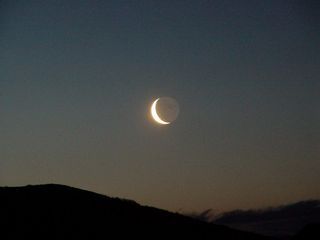 At this time of year where we live, it's dark by the time the students and I pour forth from the synagogue at the end of Monday afternoon Hebrew school. And now that my son is in kindergarten, he comes to Monday Hebrew school just as the older kids do. So the two of us walk out of the shul together into the afternoon dark.
At this time of year where we live, it's dark by the time the students and I pour forth from the synagogue at the end of Monday afternoon Hebrew school. And now that my son is in kindergarten, he comes to Monday Hebrew school just as the older kids do. So the two of us walk out of the shul together into the afternoon dark.
Last night as we approached the car, he looked up at the sky and crowed, "I see the moon!" And then, a moment later, he added -- with wonderment -- "it's a crescent, but I can see the rest of it, look, it's dark grey!" I told him that this is a waxing crescent moon; we are four days into the lunar month of Kislev, so the moon is growing bigger.
The waxing crescent moon is beautiful, of course... and so is the more muted light which my son admired on the remainder of the satellite, the dim but perceptible silhouette of the rest of the moon. That pale glow, it turns out, is earthshine -- light reflected from the earth onto the moon. When the moon is a crescent, if we could stand on its surface we would see a full earth hanging in space. Earthshine is the glow from the full earth, reflected back onto the night side of the moon.
Earthshine isn't visible all night long -- only for a short while after sunset, and a short while before sunrise. But if you catch the crescent moon at those liminal times, you can glimpse the rest of the moon, too. That the moon illuminates the earth is no surprise to me. The full moon is a thing of beauty, and shines so brightly! But that our earth illumines the moon in turn -- I never knew that. I'd seen it before, but didn't know what it was.
In Jewish tradition the moon can represent Shekhinah, divine Presence: sometimes hidden and sometimes revealed, but always with us. If the moon represents divine Presence, then maybe earthshine represents how our yearning for God makes God more present, more "visible," to us. As we gaze upward and yearn for the One, the light of our souls shines forth -- and even though our individual lights are tiny, collectively we shine enough light to illuminate God from afar.
As earthshine illuminates the moon which in turn beams more light upon us, so our souls -- thirsty for connection -- shed light on God Who pours light down on us in turn. Earthshine only manifests when the moon isn't full -- or in Jewish mystical language, it's precisely when God seems most hidden that we are called to yearn and to seek. (The Zohar has a phrase for this: אתערותא דלתתא, "arousal from below." Sometimes connection between us and God comes from "on high;" other times it's sparked by our yearning "from below.")
There are times when God's light is brilliant -- full moon, as it were. And there are times when God's light is scant... and it's precisely at those times when our yearning can most fully call divine light forth, just as earthshine is only possible when the moon is mostly hidden from view. God's hiddenness is an invitation to us to seek and to yearn. And the very act of our seeking makes God more findable -- just as the light of our faraway planet helps the moon herself to shine.

November 15, 2015
Ladder (a tiny Hasidic teaching on this week's Torah portion)
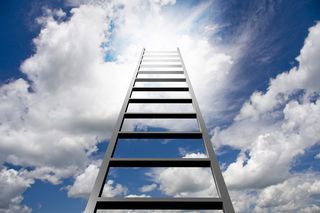 In this week's Torah portion, Jacob goes forth from Beersheva. He lies down with his head on the stones of a particular place, and he dreams of a ladder planted in earth with its head in the heavens and angels flowing up and down.
In this week's Torah portion, Jacob goes forth from Beersheva. He lies down with his head on the stones of a particular place, and he dreams of a ladder planted in earth with its head in the heavens and angels flowing up and down.
(When he wakes, he says "God was in this place, and I -- I did not know!" That's one of my favorite verses of Torah. I love that sense of wonder.)
The Degel Machaneh Efraim -- grandson of the Baal Shem Tov -- teaches that this is a passage about expansive mind and contracted consciousness. The angels moving up and down the ladder are a representation of the natural ebb and flow of our lives as we move from big mind to small mind, from a God's-eye view of the world to a limited human view and back again.
The thing is, our ascent and our descent are inevitably interconnected. Ascent leads to descent which leads to ascent again. When a tzaddik, a righteous person, falls from a high level (perhaps through losing sight of the big picture and getting mired in "small mind"), the experience of having-fallen gives rise to yearning which pulls him back up. Our low places spur us to climb.
I love this teaching about gadlut (expansive consciousness) and katnut (contracted consciousness) -- that they are interrelated; that falling is precisely the first step in rising again. And I love the idea that it's our distance from God, or our distance from expansive consciousness, which makes us yearn to erase that distance and be our best selves once again.

November 13, 2015
The freedom seder, feminist seders, and transformation
Yesterday afternoon I gave a talk as part of Colorado University's second biannual Embodied Judaism Symposium, "Freedom Seder: American Judaism and Social Justice." I spoke about how Rabbi Arthur Waskow's historic 1969 Freedom Seder helped to pave the way for the feminist seder movement and for a broader shift in how we understand seders and the story at their heart -- and about how that work was, and is, a core part of Jewish Renewal.
For those who are interested, here are the slides from my talk. Video should be forthcoming on YouTube -- stay tuned!
The freedom seder, feminist seders, and transformation from Rachel Barenblat
Thanks again to the folks at CU for inviting me to speak. It was an honor to represent ALEPH among such luminaries as Professor Riv-Ellen Prell (Professor of American Studies at the University of Minnesota), Professor Adam Bradley (Founding Director of the Laboratory for Race and Popular Culture at CU-Boulder), and Rabbi Arthur himself.

November 11, 2015
Off to Colorado
I'm traveling to Colorado today for a very brief visit (flying west today, and back east on Friday -- truly short and sweet!) in order to speak at a Colorado University Embodied Judaism Symposium on the Freedom Seder (about which I posted recently.)
I've grown accustomed to going to Boulder once a year for the OHALAH conference of Jewish Renewal clergy, and a couple of summers ago I traveled there in August for the Remembering Reb Zalman memorial. But it feels a little bit strange to be going there for a purpose other than davening, learning, and reconnecting with my Jewish Renewal hevre (beloved colleague-friends).
Of course, I do expect to see some of my hevre at this symposium. The conference is honoring Rabbi Arthur Waskow, who has been a part of Jewish Renewal from the beginning. And there are some wonderful Jewish Renewal folks who call Boulder home, some of whom will probably be joining us. But this symposium is an academic enterprise, not an explicitly spiritual one, and it's open to a broad audience, not just Jewish Renewal clergy.
Colorado University is graciously putting me up at the Boulderado, a beautiful old hotel in downtown Boulder. That feels like a strange kind of homecoming too, because my first several OHALAH conferences were held there! (I still have fond memories of a late-night liturgy class there in the hotel bar.) I suspect that as I walk through the building, I will perennially feel as though I am almost glimpsing old friends and dear teachers just out of the corner of my eye.
If you'll be at the symposium, I hope you'll come up and say hi! Once the event is over there will be guided tours of the Freedom Seder exhibit and the exhibit on the work of Reb Arthur, and I imagine I will be hanging around there chatting with whoever wants to talk. I'll post my slides on Friday, so stay tuned...

November 10, 2015
Lamp
When grief has
splashed my fire out,
when my sanctuary
is dark, smeared
with boot prints
and wet ashes
when the holy of holies
inside my rib cage
is an aching void
It is you who wipe
tears from my face
with tender hands
who remind me
I deserve better
than desolation
who light my lamp.
Bring me your flame.
I want to shine again.
Last week I attended a funeral at which verses from psalm 18 were read -- including verse 29, which says to God, "You light my lamp[.]" That image resonated with me, and I wrote this poem on the plane home.
This will probably be one of the 36 poems of love and longing which make up Texts to the Holy.
Speaking of which, I'm delighted to be able to share that one of the poems from that manuscript will appear in a future issue of Presence: an International Journal of Spiritual Direction. I'll let y'all know when it's published.

November 9, 2015
Then why am I?
At the very beginning of this week's Torah portion, Rebecca feels her twins struggling for dominance in her womb. Her response is an existential question: "If this is so, then why am I?" Every year when we reach this parsha, this verse leaps out at me. And every year when I apply the diamond of this verse to my own life, it reveals a different facet of my own heart and mind. (I love that about Torah study.)
If this is so, then why am I? This year the question resonates for me in an interpersonal way. There are people I love who are sick, and I am helpless to heal them. There are people I love who are in tight straits, and I am helpless to free them. There are people I love who are suffering, and I am helpless in the face of what they're going through. I want so much to make things better -- and I can't.
Rebecca's question reverberates in me. If I can't bring comfort, if I can't bring healing, if I can't make things better, then what am I doing here? Why am I even, if I can't balm the suffering of those I love? It's not an intellectual question, but a heart-question. Something is wrong and I can't fix it even though I yearn to do so with all of who I am. If I can't make it better, what am I even doing here?
Rebecca brings her question to God, and God gives her a narrative answer: there is a struggle inside her because she is carrying twins who are destined to tussle with each other. When I bring this same question to God, the answer I receive is just one word: love. Why am I? Love. What am I here for? Love. What can I extend to those in my life who are sick or suffering or grieving? Love. Only love.
I imagine that as my heart overflows for those in my life who are in tight places, so God's heart overflows for all of us. I think there's something about the experience of yearning to make things better for a beloved which is integral to human life -- and maybe this is part of what Torah means when it says that we are made in the divine image and likeness. As God feels compassion, so do we.
And maybe that is itself an answer to Rebecca's question. That's what we're here for. To feel with others, to feel for others. To wish we could make things better for each other. Even when we can't fix, we can choose to continue to feel; we can choose to continue to love; we can choose not to turn away.
Related:
Rivka's questions, our answers, 2006
Why am I and how can I integrate?, 2013
Peace parsha: if this is so, then why am I?, 2014

November 4, 2015
Announcing Annunciation
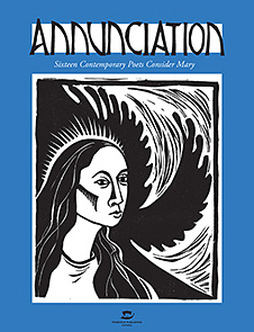 Many months ago, my friend and publisher Beth Adams, of Phoenicia (which brought out my first two books, Waiting to Unfold and 70 faces: Torah poems), asked whether I had ever written a poem about Mary. She was exploring the idea of a collection of poems about Mary accompanied by her own original linocut prints, and she wanted the poets represented in the volume to come from a variety of faith-traditions: Jewish, Christian, Muslim, Hindu, secular. She wrote:
Many months ago, my friend and publisher Beth Adams, of Phoenicia (which brought out my first two books, Waiting to Unfold and 70 faces: Torah poems), asked whether I had ever written a poem about Mary. She was exploring the idea of a collection of poems about Mary accompanied by her own original linocut prints, and she wanted the poets represented in the volume to come from a variety of faith-traditions: Jewish, Christian, Muslim, Hindu, secular. She wrote:
"The annunciation story is a complicated foundational story in western culture. Patriarchies have used Mary as a model for ideal female acceptance, faith, and submission to authority, while at the same time millions of people have identified with her courage, suffering, and patience, and accorded her their personal devotion and deep respect.
I suspect that if we look closely, most of us may have been touched by her story in some way . I want to encourage you to look at the annunciation from a modern point of view, as contemporary poets of different cultural backgrounds. Your work can be religious or secular, traditional or decidedly not, written in a feminist light, a current-events light, a personal light. I'm not looking for any particular type of thrust or interpretation, but rather a broad range of responses to this story and this person we know as Mary. I want to encourage you to think deeply and fearlessly, and to write from your hearts."
I did not have any poetry about Mary, but I spent some time learning and researching and praying and then I wrote a poem to contribute. So did fifteen others.
Announcing Annunciation: sixteen contemporary poets consider Mary -- brand-new from Phoenicia Publishing, and available before November 20 at a special pre-publication discount of $17.95. Ten percent of proceeds from the book will be donated to benefit refugee women.
On the publisher's website you can read process notes from the sixteen poets -- among them Ivy Alvarez, Kristin Berkey-Abbott, Chana Bloch, Luisa A. Igloria, Mojha Kahf, Marly Youmans. (What great company to be in!) Also on that page you can read about the process of making the original linocut relief prints which Beth created in response to our poems. (I have a small framed print of Beth's in my synagogue office -- I love her work, and can't wait to see the images in this volume.)
Read about the book, and buy yourself (or someone else!), a copy here: Annunciation.

November 2, 2015
The gift of another Listening Tour Shabbat
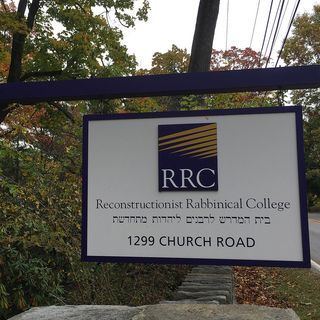 If you've been reading this blog lately you know that my ALEPH co-chair Rabbi David Evan Markus and I are traveling around North America on the ALEPH / Jewish Renewal Listening Tour. We're visiting congregations and communities, visiting rabbinic schools (both trans-denominational, e.g. Hebrew College -- and denominational, e.g. the Reconstructionist Rabbinical College), holding big open mic sessions and small curated conversations, and learning as much as we can about the landscape of Jewish Renewal and about people's hopes and dreams for the future of Judaism writ large.
If you've been reading this blog lately you know that my ALEPH co-chair Rabbi David Evan Markus and I are traveling around North America on the ALEPH / Jewish Renewal Listening Tour. We're visiting congregations and communities, visiting rabbinic schools (both trans-denominational, e.g. Hebrew College -- and denominational, e.g. the Reconstructionist Rabbinical College), holding big open mic sessions and small curated conversations, and learning as much as we can about the landscape of Jewish Renewal and about people's hopes and dreams for the future of Judaism writ large.
Celebrating Shabbat on these trips is turning out to be really special for me. One reason for that is that everywhere we go, I am reconnecting with friends who I don't see often enough. My ALEPH hevre (colleagues and friends) live all over the globe, and while it's wonderful to study and daven with them via zoom or Skype, it's far sweeter to be together in person. Another reason is that that everywhere we go, I get to relax into the capable hands of someone else's service leadership and let the liturgy and the melodies carry me. (That's a real treat for a working pulpit rabbi. Usually it's my job to help create that experience for others.)
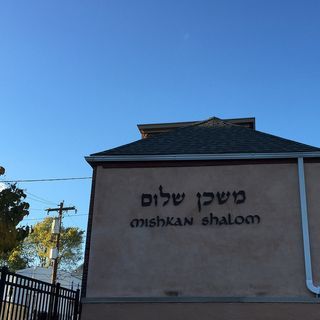 Everywhere we go, I get the opportunity to see some of my Jewish Renewal friends and teachers in the places where they live and serve, which offers me subtly different glimpses of them than I typically see on retreat. I love getting to see my hevre in their home contexts!
Everywhere we go, I get the opportunity to see some of my Jewish Renewal friends and teachers in the places where they live and serve, which offers me subtly different glimpses of them than I typically see on retreat. I love getting to see my hevre in their home contexts!
And everywhere we go, I know I'm with other people who invest in Shabbat in the same ways that I do. That's spiritually nourishing for me in ways which are difficult to verbalize. All weekend long, I get to daven surrounded by some dear voices, and faces, and neshamas (souls.) In Philadelphia, that was extra-sweet for me because I was davening in the shuls of some of the very people who most taught me how to enter the flow of the liturgy and really pray.
On Friday night at Mishkan Shalom, Rabbi Shawn Zevit led a beautiful Kabbalat Shabbat. At the start of that service, the experience of singing Yedid Nefesh -- that gorgeous poem of love and yearning -- cracked my heart right open and let the balm of Shabbat flow in. I had the opportunity to share a few poems during Friday night's service -- including "Texts to the Holy," (a poem I posted here in slightly earlier form as "Missing You") which I had never read aloud to others before. Friday night's davenen opened me up in beautiful ways.
On Saturday morning at P'nai Or davenen was led by Rabbi Marcia Prager and Hazzan Jack Kessler. We began with an opening niggun which I know like the back of my own hand but hadn't heard in a long time. The simple experience of singing harmony for those familiar notes was sweet. By the time we got to the lines in Nishmat Kol Chai which assert that everything within me sings praise, those words were entirely true. Shabbat morning's davenen filled my cup to the brim. And then, after a potluck lunch, we held an open mic session for more than 50 people who shared with us their hopes and dreams for the future of Jewish Renewal -- holy wow.
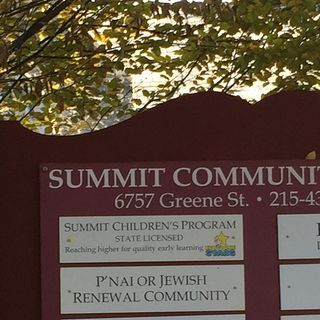 Part of what's fun for me is that each of the services we've attended thus far on the Listening Tour has been entirely different from the others. Each has featured a different siddur (prayerbook). Each has been led by people who were ordained in different places. (Of this weekend's davenen leaders, two hold dual ordination from the Reconstructionist Rabbinical College, and from Reb Zalman z"l whose work inspired and grew into the ALEPH Ordinations Program; one was ordained by the Conservative Jewish Theological Seminary.) Each has featured different melodies, choices of instrumentation, and styles of prayer. And each has been an authentic expression of Jewish Renewal, because there's no single way to "do" Renewal.
Part of what's fun for me is that each of the services we've attended thus far on the Listening Tour has been entirely different from the others. Each has featured a different siddur (prayerbook). Each has been led by people who were ordained in different places. (Of this weekend's davenen leaders, two hold dual ordination from the Reconstructionist Rabbinical College, and from Reb Zalman z"l whose work inspired and grew into the ALEPH Ordinations Program; one was ordained by the Conservative Jewish Theological Seminary.) Each has featured different melodies, choices of instrumentation, and styles of prayer. And each has been an authentic expression of Jewish Renewal, because there's no single way to "do" Renewal.
People keep asking how we're managing to do this listening tour on top of jobs and other commitments. This year of traveling and active listening poses a lot of challenges -- from the emotional and intellectual effort to be receptive listeners, to ordinary logistics, to grasping the awesome scope of all people hold Renewal to be (and want Renewal to be). But the work is its own reward: I can't imagine a better way to spend these weekends.
Not only because it's amazing to get to hear from so many people about the Jewish future they yearn for (though it is) -- not only because we get to have these incredible conversations about ALEPH and Jewish Renewal and the future of heart-centered innovative Judaism (though we do, and how cool is that?) -- but also because we get to experience Jewish Renewal Shabbatot in all of these different places. Each Shabbat on this tour has its own ta'am, its own flavor. Each one comes with different melodies, and harmonies, and insights, and sweetness. And each one is a gift.

October 29, 2015
Ten years with the angels
1.
The year is 2005. I am at the old Elat Chayyim -- in its original campus, the Catskills hotel in Accord, NY. It is "smicha students' week" and I am not yet a student. I'm spending the week with the ALEPH Ordinations Programs community: learning with them, dining with them, davening with them.
This is part of our mutual discernment process: is this the right program for me? (I know in my bones that it is.) Am I the right fit for them? (I pray with my whole heart that I am.) I am staying in a room with two students and another applicant. I don't yet know that I will begin the program in the fall.
DLTI -- the Davenen Leadership Training Institute -- is meeting during this same week. I will realize, years later, that this must be their third session of four. Their facility with leading prayer, and the way their energies and harmonies interweave seamlessly, would not be possible during week one.
But at this moment I don't know that, and I'm mostly just awed by the way they lead prayer. This is the first time in my life that I hear weekday nusach, the melodic mode used for weekday davenen, and I fall in love with it instantly. It's also the first time I ever hear an invocation of the angels at bedtime.
One night, my room-mates who are in the program sing it to the two of us in the room who are applicants. The melody is by R' Shlomo Carlebach z"l. "In the name of God, the God of Israel -- on my right is Michael, on my left is Gavriel..." When did anyone last sing me a lullaby? It brings me to tears.
2.
The year is 2010. I am once again at smicha students' week -- this time at Pearlstone, a Jewish retreat center outside of Baltimore. I am spending two weeks there with the entire AOP community. It will be my last summer residency as a rabbinic student. It is also my first summer residency with a baby.
My mother spends a week there taking care of the baby so that I can go to class. She brings him to me when he needs to nurse, and otherwise she strolls him around the grounds, reads him board books, plays with him. One night she asks me the name of the beautiful Israeli folksong I sing him at bedtime.
It takes me a moment to realize that she means this piece of traditional liturgy, set to R' Shlomo's melody. I explain that this is an invocation of the angels -- Michael, Gavriel, Uriel, Raphael -- to watch over us while we sleep. Part of the liturgy of the bedtime shema. Every night, she listens to me sing.
3.
The year is 2015. I am perched on the edge of my son's bed. "Do you want me to say the prayers tonight, or do you want to say them?" I ask. Tonight he wants to do them himself. He blesses everyone. He sings the shema. And then he sings me the angel song, in Hebrew and in English.
Some of the Hebrew words are a bit garbled. And I have no idea what he thinks an angel is. But in this moment, I am awestruck. Ten years ago the idea of invoking the angels of wonder, strength, light, and comfort was new to me. Five years ago, it was new to my mom. But this is not new to my son.
For him, this is ordinary. A natural part of the bedtime routine, just like saying "God bless..." and singing the shema. And sometimes now, before his own bedtime, my son sings the angel song to me -- just as my friends did, bringing me to tears in that dorm room at the old Elat Chayyim, a lifetime ago.
Related:Bedtime angels, July 2015

October 28, 2015
When sadness and joy co-exist - at The Wisdom Daily
My latest short piece for The Wisdom Daily is excerpted from a longer post I'm writing about Jay Michaelson's new book The Gate of Tears, which just came out this month from Ben Yehuda Press. Here's a taste:
Sadness can feel like something shameful, especially for people (like me) who make a practice of practicing gratitude. But sadness is a necessary part of the emotional landscape.
It's worth noting: Sadness is not the same as depression. The book distinguishes between the two, and so do I. Depression flattens me and makes life feel un-liveable. Sadness is different.
Feeling sad hurts, of course. Sadness can come in waves so intense they take my breath away for a time. But the emotion passes, and in its wake I feel the joy of being alive. And sometimes, on rare occasions, I can feel that joy even while sadness is present. For me, that's the experience at the heart of The Gate of Tears.
Read the whole thing here: When Sadness and Joy Co-Exist. (And stay tuned for my longer piece in response to the book -- coming soon.)

Rachel Barenblat's Blog
- Rachel Barenblat's profile
- 6 followers




